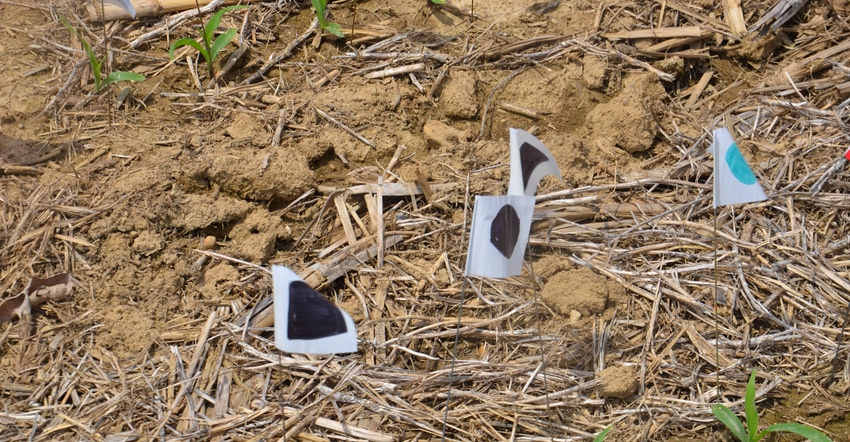
Indy race car drivers want to see black in the flag above the racecourse, but only if it’s in a black and white, checkered pattern, indicating they just won the race. The last thing any driver wants to see is a solid black flag. Race officials wave this flag when there is a serious problem with a car. It signifies that the driver should come into the pits immediately. Often, it’s the beginning of the end for his or her day.
In 2021, corn in the Corn Watch field was planted April 25, and then subjected to a stretch of cool, wet weather. The first plants emerged 12 days after planting. That’s when the first flags went into the ground in 1/1,000 lengths of rows designated for spot-checking emergence. Because conditions weren’t favorable, emergence drug out over the next two weeks. Instead of emerging uniformly, some plants emerged nine to 14 days after the first plants within the same row emerged. A flag with a black square or black circle was placed next to each super-late-emerging plant.
Related: Why is this corn plant yellow?
Was it the end of the line for all black-flagged plants? Some advertising and even some field trials might suggest plants emerging that late won’t produce ears. In this case, plants were followed to harvest. All but a very few of those “black-flagged” plants produced ears, ranging from nubbins to full-size, half-pound ears.
“It’s fair to say that as emergence is delayed, ear size from those plants at the end of the season is more erratic,” Dave Nanda observes. He is director of genetics for Seed Genetics Direct, sponsor of Corn Watch ’22. “However, one should be careful with generalizations. That field still yielded over 205 bushels per acre, even though there were also issues with nitrogen loss due to very wet soils.”
Seek solutions
What observing delays in emergence should do is encourage you to ask questions to determine why it happened, Nanda says. Then take steps to reduce the odds of it happening again next season.
“We’ve learned a lot from flagging emergence,” he says. “If the weather turns cool and wet after planting, it increases the odds for more variation in emergence, especially on soils that aren’t well-drained or tile-drained.
“There can be row-to-row differences too. They may occur because some rows place seeds deeper than others, or they could be due to changes in microclimate and soil type across the field. A 24-row planter on 30-inch rows covers 60 feet, and conditions can change.”
Monitoring emergence in these fields has also led Nanda to another conclusion.
“Spacing within the row between plants or gaps where there are no plants can affect yield as much or more as delays in emergence,” he says. “If you’re going to flag emergence and then monitor it all the way to harvest, be sure to also document where there are skips and doubles. Ears will be somewhat bigger if a plant has more room, and smaller if the plant is crowded.”
About the Author(s)
You May Also Like




